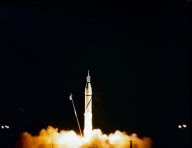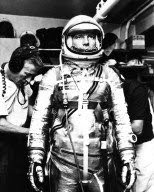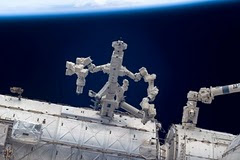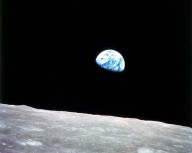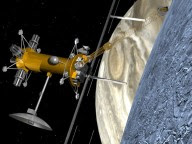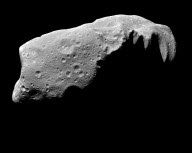Monday, December 20, 2010
A Lunar Eclipse on Solstice Day
A Galaxy for Everyone
Download full size image International Astronauts Arrive At Space Station
The Soyuz TMA-20 docked two days after blasting off from the Baikonur Cosmodrome on the Kazakh steppe. The shuttle carried NASA astronaut Catherine Coleman, Russian cosmonaut Dmitry Kondratyev and the European Space
Click here to find out more!
Agency's Paolo Nespoli of Italy.
"The approach and the docking of the ship with the station was carried out under the control of the space command center," according to a statement found on the Roscosmos website www.roscosmos.ru.
The Russian news agency Interfax reported late Thursday that Russia's space command center had lost contact with the spaceship, but hours later information from the craft had starting flowing again.
The Soyuz flight is one of the last before NASA retires its space shuttle fleet, leaving astronauts completely reliant on the Russian spacecrafts for missions to the International Space Station.
---
Image Caption: TMA-20 mission patch (Credit: Roscosmos)
NASA Fuels Space Shuttle Discovery to Test Damaged Tank
NASA Information-Dissemination Product Inventories, Priorities and Schedules
Members of the public can provide input into how NASA disseminates information through the Web portal by using the "comments" link on the Contact NASA page.
NASA Spacecraft Provides Travel Tips for Mars Rover
Thursday, December 9, 2010
Elon Musk on Dragon's Success: "It's Just Mind-Blowingly Awesome."
With the success of the SpaceX Falcon 9/Dragon mission still fresh, SpaceX CEO Elon Musk said the flight "has really been better than I expected. It's actually almost too good."
The Falcon 9 lofted the Dragon capsule into orbit this morning at 10:43 a.m. EST, lifting off from Launch Complex 40 at Cape Canaveral Air Force Station in Florida, a few miles south of the space shuttle launch pads. The Dragon returned to Earth at about 2:02 p.m., safely splashing down in the Pacific Ocean following two orbits. It marked the first time a commercial company has recovered a spacecraft from orbit.
"There's so much that can go wrong and it all went right," Musk said. "I'm sort of in semi-shock."
NASA officials also were very pleased with the mission's results.
"This is really an amazing accomplishment for SpaceX," said Alan Lindenmoyer, NASA's Commercial Crew and Cargo Program Manager. "Thank you for the early Christmas present."
The mission was a demonstration flight under NASA's Commercial Orbital Transportation Services, or COTS, contract.
"We would not be here without the help of NASA, I cannot emphasize that enough," Musk said.
Tuesday, November 16, 2010
Discovery's External Fuel Tank Repair Progress
Another team of technicians is working on repairing cracks on the tops of two, 21-foot-long support beams, called stringers, on the exterior of the external tank in an area known as the intertank. The team includes personnel from the external tank manufacturing plant in Louisiana, the Michoud Assembly Facility.
Over the weekend, technicians removed a section of one of the stringers that had two, 9-inch cracks in it. Last Friday, during foam removal and inspection of adjacent stringers to the one with the 9-inch cracks, technicians identified a crack about 3-inches long on the left-hand adjacent stringer. Further foam removal revealed one additional corresponding crack on the same left-hand adjacent stringer. Technicians plan to remove that section of the stringer Monday night. They’ll also install a new section of metal, called a doubler because it’s twice as thick as the original stringer metal, on the stringer that had the 9-inch cracks.
Engineers continue evaluating the intertank for any potential issues, but so far no other cracks have been found beyond the ones on the two previously identified stringers. There are a total of 108 stringers on the intertank.
Senior managers plan to meet on Nov. 22 at NASA’s Johnson Space Center and via video conference for a launch status briefing to assess and review the repair work and launch preparations. Although managers have not set a new target launch date for Discovery’s STS-133 mission to the International Space Station, the repair work and planning still are aimed at supporting an attempt in the upcoming launch window that opens Nov. 30.
Statement by NASA Administrator Charles F. Bolden on the Chilean Miners Rescue
“On behalf of the entire NASA family, I want to ask that our heartfelt thoughts and prayers continue to go out to the courageous miners, their families and friends, and the dedicated people who have been working to safely reach those who are still trapped underground.
“There is a lot of hard work ahead for rescuers, but the Chilean government and the people of that great nation should be praised for their steadfast determination. Their unwavering commitment is the reason we are witness to the joyful and emotional reunions today as the miners are returned to the surface one-by-one.
“I also want to express my personal thanks to the Americans who have assisted in this heroic effort, and specifically the NASA team that traveled to Chile in the early days of the crisis. For decades, the people of this agency have learned to live, work, and survive in the hostile environment of space. Our expertise in maintaining physiological and psychological health, and our technical and engineering experience in spacecraft design all proved to be valuable in a situation that is far from our traditional scope of work.
“I am proud of the people of this agency who were able to bring the experience of spaceflight down to Earth when it was needed most. As the drama of this rescue continues to unfold before us, we pray for the safe return of each and every miner.”
Charles Bolden
NASA Administrator
Antarctic Science Mission Media Briefing
IceBridge Logo NASA will hold a media teleconference at 2 p.m. EST on Monday, Nov. 15, from Punta Arenas, Chile, to discuss the agency's Operation IceBridge. Researchers are using seven instruments aboard NASA's DC-8 flying laboratory to map Antarctic ice surfaces and the features hidden below. The data are critical for understanding the dynamics of ice in West Antarctica and its impact on sea-level rise.
During the briefing, IceBridge scientists will provide an overview of the multi-year mission and an update on flights under way over Antarctica. They also will describe some of the observations made since flights began on Oct. 26.
Briefing Participants
 Michael Studinger Michael StudingerIceBridge project scientist, NASA Goddard Space Flight Center/University of Maryland, Baltimore County |  Seelye Martin Seelye MartinResearch scientist (sea ice), University of Washington, Seattle |
Print-Quality Images
› Link to Images
› Link to Videos/Animations
› Download the Full Presentation
Media Contacts
Steve Cole
Headquarters, Washington
202-358-0918
stephen.e.cole@nasa.gov
Sarah DeWitt / Kathryn Hansen
Goddard Space Flight Center, Greenbelt, Md.
sarah.l.dewitt@nasa.gov / kathryn.h.hansen@nasa.gov
How will the Earth system change in the future?
As the world consumes ever more fossil fuel energy, greenhouse gas concentrations will continue to rise and Earth's average temperature will rise with them. The Intergovernmental Panel on Climate Change (or IPCC) estimates that Earth's average surface temperature could rise between 2°C and 6°C by the end of the 21st century.
For most places, global warming will result in more hot days and fewer cool days, with the greatest warming happening over land. Longer, more intense heat waves will happen more often. High latitudes and generally wet places will tend to receive more rainfall, while tropical regions and generally dry places will probably receive less rain. Increases in rainfall will come in the form of bigger, wetter storms, rather than in the form of more rainy days. In between those larger storms will be longer periods of light or no rain, so the frequency and severity of drought will increase. Hurricanes will likely increase in intensity due to warmer ocean surface temperatures. So one of the most obvious impacts of global warming will be changes in both average and extreme temperature and precipitation events.
Scientists are also monitoring the great ice sheets on Greenland and West Antarctica, both of which are experiencing increasing melting trends as surface temperatures are rising faster in those parts of the world than anywhere else. Each of those ice sheets contains enough water to raise sea level by 5 meters and if our world continues to warm at the rate it is today then it is a question of when, not if, those ice sheets will collapse. Some scientists warn we could lose either, or both, of them as soon as the year 2100.
Ecosystems will shift as those plants and animals that adapt the quickest will move into new areas to compete with the currently established species. Those species that cannot adapt quickly enough will face extinction. Scientists note with increasing concern the 21st century could see one of the greatest periods of mass extinction of species in Earth's entire history. Ultimately, global warming will impact life on Earth in many ways. But the extent of the change is up to us.
Related missions: http://science.nasa.gov/earth-science/big-questions/how-well-can-we-predict-future-changes-in-the-earth-system/
Wednesday, November 10, 2010
NASA Leaders Receive Awards From Women in Aerospace
NASA Deputy Administrator Lori Garver speaks after being given the Women in Aerospace's Outstanding Member Award at the organization's annual awards ceremony and banquet held at the Ritz-Carlton Hotel in Arlington, VA
Image Credit: NASA/Bill Ingalls
NASA's Associate Administrator of the Science Mission Directorate Dr. Edward J. Weiler presents the Women in Aerospace's Lifetime Achievement Award to retired NASA chief astronomer Nancy Grace Roman at the organization's annual awards ceremony and banquet.
Image Credit: NASA/Bill Ingalls
› View Larger
Four current NASA leaders and one retiree were recognized for their work by Women in Aerospace at the organization's annual awards ceremony and banquet on Tuesday, Oct. 26. The event celebrates women's professional excellence in aerospace and honors those who have made outstanding contributions to the aerospace community.
NASA leaders who were honored at the 2010 awards are: Deputy Administrator Lori Garver, Director of NASA's Langley Research Center Lesa Roe, Program Planning Specialist Beth Beck, Aerospace Engineer Jill Lynette Hanna Prince and Nancy Grace Roman, who retired from NASA in 1979 as chief astronomer.
NASA Administrator Charlie Bolden presented Women in Aerospace's Outstanding Member Award to Garver, noting her ongoing leadership and participation in the organization and her passion and dedication to opening the high frontier of space to the everyday person.
Bolden said, "On behalf of NASA, I want to recognize all of our honorees for the breadth of their accomplishment and the passion they bring to the agency. Their achievements are truly enlarging our field and amazing the world."
Prince, an aerospace engineer at NASA's Langley Research Center in Hampton, Va., received the Achievement Award for her work in the development of autonomous aerobraking, used on missions such as the Mars Reconnaissance Orbiter, and her contributions to planetary mission atmospheric flight.
Recognized for her dedication and innovative contributions to building public awareness for aerospace, Beck received the Aerospace Awareness Award. She is an outreach program manager in the Space Operations Mission Directorate at NASA Headquarters in Washington.
Roe was a co-recipient of the Leadership Award for her dedication to inspiring current and future generations of women and her work to deliver innovative solutions to meet the nation's aerospace and atmospheric science challenges. The co-recipient of the Leadership Award was Mina V. Samii, vice president of Computer Sciences Corporation in Lanham, Md.
A highlight of the evening was when NASA's Ed Weiler, associate administrator for the Science Mission Directorate at NASA Headquarters, presented Women in Aerospace's Lifetime Achievement Award to Nancy Grace Roman, who was NASA's chief astronomer before her retirement. Weiler reviewed Roman's esteemed career at NASA and her trailblazing role in astronomy and government leadership, noting that her efforts were instrumental in making the Hubble Space Telescope a reality.
In addition to the NASA recipients, Alison Flatau, associate dean and professor at the University of Maryland, College Park, received the Aerospace Educator Award, and Donna K. Collins, director, Program Management, at Lockheed Martin Aeronautics Company in Ft. Worth, Texas, received the International Achievement Award.
The evening also included the awarding of the first WIA scholarship, funded by the WIA Foundation, and given to women pursuing undergraduate technical degrees to encourage them to enter careers in the aerospace field. Whitney Lohmeyer, a senior at North Carolina State University, was the recipient.
Women in Aerospace is celebrating its 25th anniversary, and NASA leaders have been involved with the organization throughout its history. The organization has previously recognized NASA leaders for their contributions. Lynn Cline, deputy associate administrator for the Space Operations Mission Directorate at NASA Headquarters, received the Outstanding Member Award in 2009.
Sunday, November 7, 2010
MAVEN Mission to Investigate How Sun Steals Martian Atmosphere

An artist's conception of the MAVEN spacecraft orbiting Mars. Credit: NASA/Goddard Space Flight Center

In the upper left of this Hubble Space Telescope image, at high northern latitudes, a large chevron-shaped area of water ice clouds mark a storm front. Along the right limb, a large cloud system has formed around the Olympus Mons volcano. Credit: NASA
› Larger image The Red Planet bleeds. Not blood, but its atmosphere, slowly trickling away to space. The culprit is our sun, which is using its own breath, the solar wind, and its radiation to rob Mars of its air. The crime may have condemned the planet's surface, once apparently promising for life, to a cold and sterile existence.
Features on Mars resembling dry riverbeds, and the discovery of minerals that form in the presence of water, indicate that Mars once had a thicker atmosphere and was warm enough for liquid water to flow on the surface. However, somehow that thick atmosphere got lost in space. It appears Mars has been cold and dry for billions of years, with an atmosphere so thin, any liquid water on the surface quickly boils away while the sun's ultraviolet radiation scours the ground.
Such harsh conditions are the end of the road for known forms of life. Although it's possible that martian life went underground, where liquid water may still exist and radiation can't reach.
The lead suspect for the theft is the sun, and its favorite M.O. may be the solar wind. All planets in our solar system are constantly blasted by the solar wind, a thin stream of electrically charged gas that continuously blows from the sun's surface into space. On Earth, our planet's global magnetic field shields our atmosphere by diverting most of the solar wind around it. The solar wind’s electrically charged particles, ions and electrons, have difficulty crossing magnetic fields.
"Mars can't protect itself from the solar wind because it no longer has a shield, the planet's global magnetic field is dead," said Bruce Jakosky of the University of Colorado, Boulder. Jakosky is the Principal Investigator for NASA's MAVEN mission, which will investigate what is responsible for the loss of the martian atmosphere. NASA selected the MAVEN (Mars Atmosphere and Volatile Evolution Mission) on September 15, 2008.
Mars lost its global magnetic field in its youth billions of years ago. Once its planet-wide magnetic field disappeared, Mars' atmosphere was exposed to the solar wind and most of it could have been gradually stripped away. "Fossil" magnetic fields remaining in ancient surfaces and other local areas on Mars don't provide enough coverage to shield much of the atmosphere from the solar wind.
| The Mars Atmosphere and Volatile Evolution Mission (MAVEN), set to launch in 2013, will explore the planet’s upper atmosphere, ionosphere and interactions with the sun and solar wind. Bruce Jakosky, MAVEN's Principal Investigator discusses the mission. Credit: NASA/Goddard/Chris Smith |
Although the solar wind might be the primary method, like an accomplished burglar, the sun’s emissions can steal the martian atmosphere in many ways. However, most follow a basic M.O., the solar wind and the sun’s ultraviolet radiation turns the uncharged atoms and molecules in Mars' upper atmosphere into electrically charged particles (ions). Once electrically charged, electric fields generated by the solar wind carry them away. The electric field is produced by the motion of the charged, electrically conducting solar wind across the interplanetary, solar-produced magnetic field, the same dynamic generators use to produce electrical power.
An exception to this dominant M.O. are atoms and molecules that have enough speed from solar heating to simply run away, they remain electrically neutral, but become hot enough to escape Mars' gravity. Also, solar extreme ultraviolet radiation can be absorbed by molecules, breaking them into their constituent atoms and giving each atom enough energy that it might be able to escape from the planet.
There are other suspects. Mars has more than 20 ancient craters larger than 600 miles across, scars from giant impacts by asteroids the size of small moons. This bombardment could have blasted large amounts of the martian atmosphere into space. However, huge martian volcanoes that erupted after the impacts, like Olympus Mons, could have replenished the martian atmosphere by venting massive amounts of gas from the planet's interior.
It's possible that the hijacked martian air was an organized crime, with both impacts and the solar wind contributing. Without the protection of its magnetic shield, any replacement martian atmosphere that may have issued from volcanic eruptions eventually would also have been stripped away by the solar wind.
Earlier Mars spacecraft missions have caught glimpses of the heist. For example, flows of ions from Mars' upper atmosphere have been seen by both NASA's Mars Global Surveyor and the European Space Agency's Mars Express spacecraft.
"Previous observations gave us 'proof of the crime' but only provided tantalizing hints at how the sun pulls it off — the various ways Mars can lose its atmosphere to solar activity," said Joseph Grebowsky of NASA's Goddard Space Flight Center in Greenbelt, Md. "MAVEN will examine all known ways the sun is currently swiping the Martian atmosphere, and may discover new ones as well. It will also watch how the loss changes as solar activity changes over a year. Linking different loss rates to changes in solar activity will let us go back in time to estimate how quickly solar activity eroded the Martian atmosphere as the sun evolved." Grebowsky is the Project Scientist for MAVEN.
As the martian atmosphere thinned, the planet got drier as well, because water vapor in the atmosphere was also lost to space, and because any remaining water froze out as the temperatures dropped when the atmosphere disappeared. MAVEN can discover how much water has been lost to space by measuring hydrogen isotope ratios.
Isotopes are heavier versions of an element. For example, deuterium is a heavy version of hydrogen. Normally, two atoms of hydrogen join to an oxygen atom to make a water molecule, but sometimes the heavy and rare, deuterium takes a hydrogen atom's place.
On Mars, hydrogen escapes faster because it is lighter than deuterium. Since the lighter version escapes more often, over time, the martian atmosphere has less and less hydrogen compared to the amount of deuterium remaining. The martian atmosphere therefore becomes richer and richer in deuterium.
The MAVEN team will measure the amount of hydrogen compared to the amount of deuterium in Mars' upper atmosphere, which is the planet's present-day hydrogen to deuterium (H/D) ratio. They will compare it to the ratio Mars had when it was young -- the original H/D ratio. The original ratio is estimated from observations of the H/D ratio in comets and asteroids, which are believed to be pristine, "fossil" remnants of our solar system's formation.
Comparing the present and original H/D ratios will allow the team to calculate how much hydrogen, and therefore water, has been lost over Mars' lifetime. For example, if the team discovers the martian atmosphere is ten times richer in deuterium today, the planet's original quantity of water must have been at least ten times greater than that seen today.
MAVEN will also help determine how much martian atmosphere has been lost over time by measuring the isotope ratios of other elements in the air, such as nitrogen, oxygen, and carbon.
MAVEN is scheduled for launch between November 18 and December 7, 2013. If it is launched November 18, it will arrive at Mars on September 16, 2014 for its year-long mission.
| So You Want to Build a Satellite? A look at MAVEN's next steps on the road to becoming a real satellite. Credit: NASA/Goddard/Chris Smith |
MAVEN is part of NASA's Mars Scout program, funded by NASA Headquarters in Washington, DC. The University of Colorado will coordinate the science team and science operations. NASA Goddard will manage the project and provide mission systems engineering, mission design, and safety and mission assurance. NASA's Jet Propulsion Laboratory, Pasadena, Calif., will navigate the spacecraft, provide the Deep Space Network, and an Electra telecommunications relay package. Instruments on the spacecraft will be provided by the University of California, Berkeley, the University of Colorado, Boulder, and NASA Goddard, with the Centre d’Etude Spatiale des Rayonnements, Toulouse, France, providing the sensor for one instrument. Lockheed Martin Corp., Bethesda, Md., will develop the spacecraft, conduct assembly, test and launch operations, and provide mission operations at their Littleton, Colorado facility.
Mission Information

Image above: The STS-133 crew members, from the left, are NASA astronauts Tim Kopra and Alvin Drew, both mission specialists; Eric Boe, pilot; Steve Lindsey, commander; Michael Barratt and Nicole Stott, both mission specialists. Image credit: NASA
Upcoming Mission: STS-133
Discovery will deliver and install the Permanent Multipurpose Module, the Express Logistics Carrier 4 and provide critical spare components to the International Space Station. This will be the 35th shuttle mission to the station.
+ Read more
Previous Mission: STS-132
Space shuttle Atlantis delivered an Integrated Cargo Carrier and a Russian-built Mini Research Module to the International Space Station.
+ Read more
Crew Returns to Johnson -- Techs to Check Out GUCP
Discovery's liftoff to the International Space Station was postponed because of a leak in the ground umbilical carrier plate (GUCP) at Launch Pad 39A, which prompted a scrub of Friday's launch attempt.
Mission managers also will look at a crack in the external tank foam that developed as supercold liquid hydrogen and liquid oxygen were being drained from the tank -- although the crack did not develop until after the launch attempt was called off.
Discovery's next possible launch opportunity comes Nov. 30 at 4:05 a.m. EST.
Space Shuttle Mission: STS-133
 Image above: The Ground Umbilical Carrier Plate, or GUCP, on the launch pad Friday morning. Photo Credit: NASA TV
Image above: The Ground Umbilical Carrier Plate, or GUCP, on the launch pad Friday morning. Photo Credit: NASA TV› Hi-res Image
› Gigapan of Launch Pad 39A
Foam Crack Detail
› Hi-res Detail of Foam
During space shuttle Discovery's final spaceflight, the STS-133 crew members will take important spare parts to the International Space Station along with the Express Logistics Carrier-4. Discovery has been moved to Launch Pad 39A at NASA's Kennedy Space Center in Florida.
Additional Resources
› STS-133 Press Kit (3.3. Mb PDF)
› STS-133 Mission Summary (778 Kb PDF)
› STS-133
› Discovery facts (351 Kb PDF)
› Discovery's Career in Photos
All About the Orbiters
› Orbiter News
› Discovery Retrospective
› The Space Shuttle Era
› Space Shuttle Tribute Images
Sunday, October 31, 2010
Shuttle Discovery set for final mission
Discovery, the oldest space shuttle in NASA's fleet, is readying for its final mission on Wednesday following repairs to leaks in a pressurisation system that has twice delayed the launch.
"Work is on schedule. We completed flight pressurisation and all went well. That is behind us now," Steve Payne, NASA test director, told reporters as the countdown to launch kicked off at 2:00 pm (1800 GMT) Sunday.
The mission, initially scheduled for Monday, was postponed so Kennedy Space Center technicians could repair quick-disconnect fittings in the system used to pressurised one of Discovery's orbital maneuvering rocket engines.
Discovery and its six American astronauts will now launch from Florida's Kennedy Space Center at 3.52pm local time on Wednesday bound for the International Space Station (ISS).
The weather forecast remains 70 per cent for favourable conditions, Kathy Winters, Cape Canaveral's senior meteorologist, said at a press briefing, adding that there were slight concerns of possible rain and clouds in the launch area.
The flight to the orbiting ISS is the fourth and final shuttle flight of the year, and the last scheduled for Discovery, the oldest in the three-shuttle fleet that is being retired in 2011.
Discovery has been the busiest shuttle in history, with a record 38 trips into space since its first launch in 1984. According to NASA, it has travelled over 230 million kilometres during that time, involving 5,628 orbits of the Earth over 351 days.
NASA has long relied on the Discovery spacecraft at key points along its 26-year career -- the launch of the Hubble Space Telescope in 1990, the first ever female shuttle pilot Eileen Collins in 1995, and in 1998 it carried US space icon John Glenn to become the oldest human to fly in space at age 77.
Its all-American crew on this voyage, including female mission specialist Nicole Stott, will deliver a pressurised logistics module called Leonardo, which will be permanently attached to the spacestation to give it more storage space.
The shuttle will also bring Robonaut 2, the first human-like robot in space, and a permanent addition to the orbiting space station, as well as spare parts.
Two space walks, for maintenance work and component installation, are scheduled.
The three US shuttles -- the other two are Atlantis and Endeavour -- are due to be sent off to become museum pieces after a final shuttle mission to the space station in late February.
That means Russian Soyuz spacecraft, a modernised version of which recently dropped off three fresh crew members to the ISS, doubling the crew to six, will for several years be the only vehicle for transporting humans into space.
However, NASA's recently approved 2011 budget has left the door open to an additional shuttle flight in June.
Shuttle countdown begins as test conductors prepare for launch
Clocks at Kennedy Space Center began ticking down from the T minus 43-hour mark, a process NASA hopes culminates in the 3:52 p.m. Wednesday blastoff of the shuttle and six astronauts to the International Space Station.
Beneath an angled two-story wall of reinforced windows 3.4 miles from the launch pad, Taffet donned a headset overlooking banks of wood-paneled consoles where experts would monitor shuttle systems around the clock for more than 70 hours until liftoff.
"There's an intensity, for sure, but a good intensity," said Taffet, a 50-year-old Rockledge, Fla., resident and United Space Alliance engineer, of the atmosphere during the three-day countdown. "Your senses are definitely heightened."
In the final hours before Discovery receives a "go" for a 39th flight, NASA and contractor test conductors like Taffet will make sure launch preparations stay on schedule and are performed safely.
The preparations include Monday's loading of fuel cells that will power Discovery in orbit, fueling of the external tank on Wednesday, setup of the crew module and the astronauts' entry into it.
With only a 10-minute window to launch the shuttle, there's little margin for delay if a challenging technical glitch arises or if rain showers approach at the wrong moment.
"If there's an issue going, there's definitely tension," Taffet said. "Sometimes countdowns are extremely smooth, and people are waiting for something to happen."
Unscripted, high-pressure moments that produce creative "work arounds" can become the most fun part of the job.
This countdown, Taffet is backing up United Space Alliance colleague John Kracsun, the lead orbiter test conductor.
Friday, October 29, 2010
Space Radar Provides a Taste of Comet Hartley 2
Trapped NASA Mars Rover finds more evidence of water on 'Red Planet'
The presence of water on Mars has become more evident, suggests a new NASA finding.
Scientists have revealed that the ground where NASA's Mars Exploration Rover Spirit became stuck last year holds evidence that water, perhaps as snow melt, trickled into the subsurface fairly recently and on a continuing basis.
Stratified soil layers with different compositions close to the surface led the rover science team to propose that thin films of water may have entered the ground from frost or snow.
The seepage could have happened during cyclical climate changes in periods when Mars tilted farther on its axis. The water may have moved down into the sand, carrying soluble minerals deeper than less soluble ones. Spin-axis tilt varies over timescales of hundreds of thousands of years.
The relatively insoluble minerals near the surface include what is thought to be hematite, silica and gypsum. Ferric sulphates, which are more soluble, appear to have been dissolved and carried down by water.
"The lack of exposures at the surface indicates the preferential dissolution of ferric sulphates must be a relatively recent and ongoing process since wind has been systematically stripping soil and altering landscapes in the region Spirit has been examining," said Ray Arvidson, investigator for the twin rovers Spirit and Opportunity.
The twin Mars rovers finished their three-month prime missions in April 2004, then kept exploring in bonus missions. One of Spirit's six wheels quit working in 2006.
Researchers took advantage of Spirit's months at Troy last year to examine in great detail soil layers the wheels had exposed, and also neighbouring surfaces.
"With insufficient solar energy during the winter, Spirit goes into a deep-sleep hibernation mode where all rover systems are turned off, including the radio and survival heaters," said John Callas, project manager for Spirit and Opportunity at NASA.
"All available solar array energy goes into charging the batteries and keeping the mission clock running," said Callas.
Spirit, Opportunity, and other NASA Mars missions have found evidence of wet Martian environments billions of years ago that were possibly favourable for life.
These newest Spirit findings contribute to an accumulating set of clues that Mars may still have small amounts of liquid water at some periods during ongoing climate cycles.
The findings were published in the Journal of Geophysical Research. (ANI)
Dead Spacecraft Walking
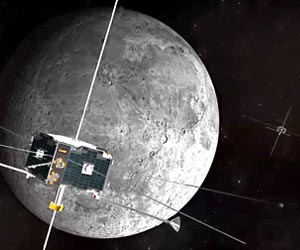 |
"Their real names are THEMIS P1 and P2, but I call them 'dead spacecraft walking,'" says Vassilis Angelopoulos of UCLA, principal investigator of the THEMIS mission. "Not long ago they appeared to be doomed, but now they are beginning an incredible new adventure."
The story begins in 2007 when NASA
Working together, the probes quickly discovered a cornucopia of previously unknown phenomena such as colliding auroras, magnetic spacequakes, and plasma bullets shooting up and down Earth's magnetic tail. This has allowed researchers to solve several longstanding mysteries of the Northern Lights.
The mission was going splendidly, except for one thing: Occasionally, P1 and P2 would pass through the shadow of Earth. The solar powered spacecraft were designed to go without sunlight for as much as three hours at a time, so a small amount of shadowing was no problem. But as the mission wore on, their orbits evolved and by 2009 the pair was spending as much as 8 hours a day in the dark.
"The two spacecraft were running out of power and freezing to death," says Angelopoulos. "We had to do something to save them."
The team brainstormed a solution. Because the mission had gone so well, the spacecraft still had an ample supply of fuel--enough to go to the Moon. "We could do some great science from orbit," he says. NASA approved the trip and in late 2009, P1 and P2 headed away from the shadows of Earth.
With a new destination, the mission needed a new name. The team selected ARTEMIS, the Greek goddess of the Moon. It also stands for "Acceleration, Reconnection, Turbulence and Electrodynamics of the Moon's Interaction with the Sun."
The first big events of the ARTEMIS mission are underway now. On August 25, 2010, ARTEMIS-P1 reached the L2 Lagrange point on the far side of the Moon. Following close behind, ARTEMIS-P2 entered the opposite L1 Lagrange point on Oct. 22nd. Lagrange points are places where the gravity of Earth and Moon balance, creating a sort of gravitational parking spot for spacecraft.
"We're exploring the Earth-Moon Lagrange points for the first time," says Manfred Bester, Mission Operations Manager from the University of California at Berkeley, where the mission is operated. "No other spacecraft have orbited there."
Because they lie just outside Earth's magnetosphere, Lagrange points are excellent places to study the solar wind. Sensors onboard the ARTEMIS probes will have in situ access to solar wind streams and storm clouds as they approach our planet-a possible boon to space weather forecasters. Moreover, working from opposite Lagrange points, the two spacecraft will be able to measure solar wind turbulence on scales never sampled by previous missions.
"ARTEMIS is going to give us a fundamental new understanding of the solar wind," predicts David Sibeck, ARTEMIS project scientist at the Goddard Space Flight Center. "And that's just for starters."
ARTEMIS will also explore the Moon's plasma wake-a turbulent cavity carved out of the solar wind by the Moon itself, akin to the wake just behind a speedboat. Sibeck says "this is a giant natural laboratory filled with a whole zoo of waves waiting to be discovered and studied."
Another target of the ARTEMIS mission is Earth's magnetotail. Like a wind sock at a breezy airport, Earth's magnetic field is elongated by the action of the solar wind, forming a tail that stretches to the orbit of the Moon and beyond. Once a month around the time of the full Moon, the ARTEMIS probes will follow the Moon through the magnetotail for in situ observations.
"We are particularly hoping to catch some magnetic reconnection events," says Sibeck. "These are explosions in Earth's magnetotail that mimic solar flares--albeit on a much smaller scale." ARTEMIS might even see giant 'plasmoids' accelerated by the explosions hitting the Moon during magnetic
These far-out explorations may have down-to-Earth applications. Plasma waves and reconnection events pop up on Earth, e.g., in experimental fusion chambers. Fundamental discoveries by ARTEMIS could help advance research in the area of clean .
After six months at the Lagrange points, ARTEMIS will move in closer to the Moon-at first only 100 km from the surface and eventually even less than that. From point-blank range, the spacecraft will look to see what the solar wind does to a rocky world when there's no magnetic field to protect it.
"Earth is protected from solar wind by the planetary magnetic field," explains Angelopolous. "The Moon, on the other hand, is utterly exposed. It has no global magnetism."
Studying how the solar wind electrifies, alters and erodes the Moon's surface could reveal valuable information for future explorers and give planetary scientists a hint of what's happening on other unmagnetized worlds around the solar system.
Orbiting the Moon is notoriously tricky, however, because of irregularities in the lunar gravitational field. Enormous concentrations of mass (mascons) hiding just below the surface tug on spacecraft in unexpected ways, causing them over time to veer out of orbit. ARTEMIS will mitigate this problem using highly elongated orbits ranging from tens of km to 18,000 km.
"We'll only be near the lunar surface for a brief time each orbit (accumulating a sizable dataset over the years)," explains Angelopoulos. "Most of the time we'll linger 18,000 km away where we can continue our studies of the solar wind at a safe distance."
The Dead Spacecraft Walking may have a long life ahead, after all.












